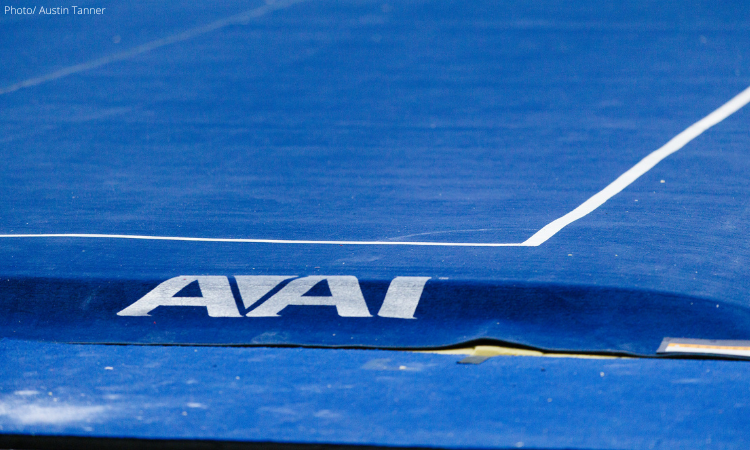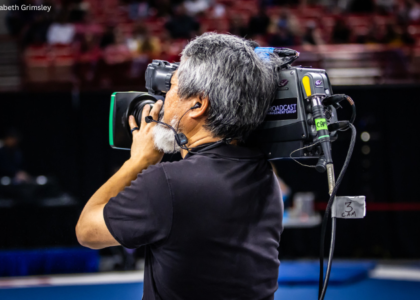The 2020s in women’s collegiate gymnastics will hopefully be known as the decade that celebrated personal agency, with a massive influx of athletes choosing to use their floor music to celebrate their culture. The gymnasts who do so are celebrated for bravely rewriting the traditions of the sport—a decision that is consciously reaffirmed with each performance.
For the eighth and final night of Hanukkah, linked below are eight pieces of instrumental music that, whether through the musician, pop culture or region of origin, are intrinsically tied to Jewish traditions. Spanning everything from klezmer music to Eurovision-winning songs, there’s something for everyone’s taste. No matter if you’re a gymnast or armchair choreographer, this list is a fun peek into the process of tying floor music to culture.
Hava Nagila
The article simply wouldn’t be done justice without starting with this music, perhaps the most recognizable piece of Jewish composition. This celebratory song is most often heard at weddings and parties but every so often is used as floor music—most famously by Aly Raisman from 2011 to 2012. Gold medal aside, her Hava Nagila floor routine was made especially meaningful by its dedication to the victims of the Munich Massacre. May their memories be a blessing.
Toy
Netta Barzilai performed one of four Eurovision winning acts from Israel, having performed Toy in 2018. Her dance-pop song reached the top of the dance charts in North America and Europe and has the same upbeat energy found across the NCAA’s “floor parties.”
Through Heaven’s Eyes
This lively number out of Dreamworks’ 1998 film Prince of Egypt is considered the turning point in the story and was written by Jewish composer Stephen Schwartz. Although Schwartz and his co-composer Hans Zimmer are both Ashkenazi Jews (of eastern European descent), this song heavily features the tambourine—indicative of Sephardi Jewish (of Middle Eastern and Mediterranean descent) musical traditions.
The Entire Fiddler on the Roof Soundtrack
Objectively the most well-known piece of theater with Jewish protagonists, Fiddler on the Roof is a timeless tale of balancing traditions with modernity. Approaching its 60th anniversary in 2024, Fiddler’s songs each convey a different set of emotions. While not the original recording, this medley by Chris Sarantakis is jam-packed with staples from the show, including Tradition, To Life and Sunrise Sunset. As an extra treat, it ends with a lively Hava Nagila.
Author’s note: I would be remissed not to mention this piece, as it was the music I used when competing at the 2022 Maccabiah Games.
Hallelujah
Initially written and performed by Leonard Cohen, the Jewish musician for the ages hails from Montreal. It cracks Rolling Stone’s top 500 songs of all time at No. 259 and has been covered by countless artists. While slow, it will always be recognizable. Zhanna Stelmakh’s cover includes the right touch of drama to keep the familiar tune fresh.
The Sinister Minister
The 1997 Grammy winner from Béla Fleck and the Flecktones has all the right components of floor music, right down to its groove that grows from the opening bass. It straddles the line between blues, jazz and bluegrass—perfect for athletes that may typically like one genre but otherwise wouldn’t venture in the direction of the other two.
Sing, Sing, Sing
This big band classic out of the 1950 has no doubt made its rounds, being used on the optional level gymnastics circuit. It was written and popularized by the ‘King of Swing’ Benny Goodman, whose parents fled Russia at the turn of the 19th Century to escape antisemitism.
Hevenu Shalom Alechem
This string rendition of Hevenu Shalom Alechem (translation: we wish/bring you peace) could fit right into a violin-heavy floor lineup. Around the one-minute mark, the quartet shifts to play Siman Tov, another joyous song verbatim wishing good luck that is often heard at weddings. If you grew up with the Wiggles, you may recognize the first tune, as they included it in their show both in 1998 and 2006.
Bonus: Sweet Caroline
While Sweet Caroline could arguably be too much of a crowd favorite to be used in a floor routine, college sports fans are no strangers to hearing it in person on gameday. Neil Diamond, born to a family of Polish-American Jews, wrote the hit ballad in 1969, and it has since become a staple of both American and Canadian sports fan culture.
READ THIS NEXT: 8 Nights of Hanukkah Features
Article by Peri Goodman
Like what you see? Consider donating to support our efforts throughout the year!



